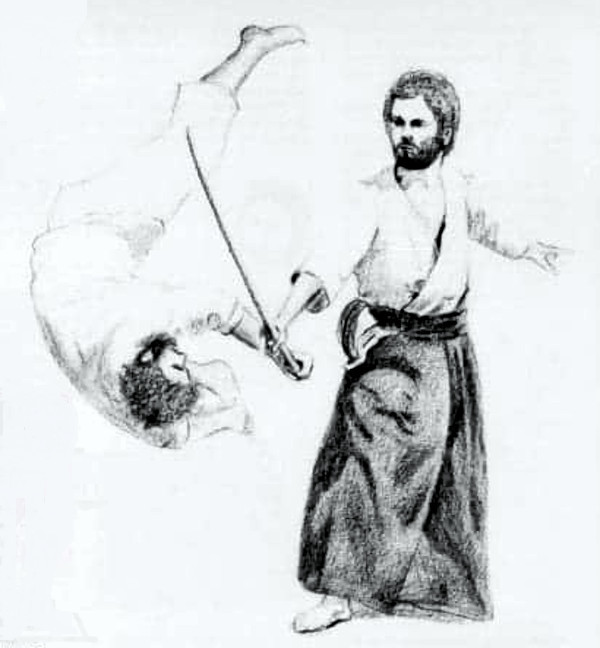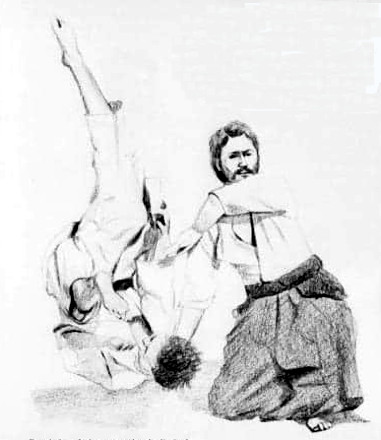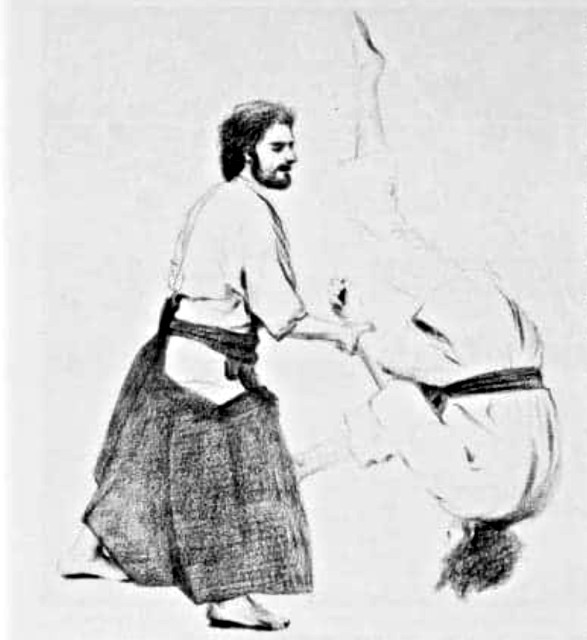
By Donald Angier
#donangier #aiki #jiujitsu #yanagiryu
(Defense World, article from Don Angier Sensei, March, 1975, pp. 11-13.)
Mr. Donald Angier studied under the late Yoshida Kenji of Japan from 1949 to 1954. At the time of Mr. Yoshida's death in 1954 Mr. Angier became the successor to the art of Shidare Yanagi Ryu Aiki Jiu Jitsu (Weeping Willow Style of the Mind Blending Art of Gentleness) . Since 1955 he has taught the art in his own schools and given lectures and demonstrations at various colleges in the Los Angeles area. The ancient Japanese prints, porcelain and collection of samurai swords gathered in his home testify to his broad interest in oriental culture and the martial arts, as do the several books he is in the process of writing.

Translated into English , Jiu Jitsu means "the Art of Gentleness" but the gentleness is expressed in the application of the art, no the effect upon the attacker.
As is the case with many ancient arts, the origin of the art of Jiu Jitsu is open to controversy and, most probably, it is irretrievably lost.
Some sources credit a monk named Chin Gen Pin who migrated to Japan from China in 1559 with bringing the art of "Kempo" (China Hand) to Japan. Supposedly he taught three samurai (warrior Knights) named Fukuno, Isogai and Miura. But ancient records such as the Nihon Shokki (Japanese Chronicle) and the Kojiki (Record of ancient matters) tell about an earlier master. They record that Tekenuchi Hisamori formed the Tekenuchi School of Jiu Jitsu in 1532.
Further the Daito Ryu Aiki Jiu Jitsu School, From which my style is descended, professes to have been founded in 880 AD by Prince Teijun, the second son of Emperor Seiwa. It should also be noted that "Kempo" is a striking art . It leaves out many techniques taught in jiu-jitsu. It is, therefore, more probable that Chin Gen Pin influenced the striking portion of the already extant jiu-jitsu system.
The above mentioned documents from Japan's Feudal era list over 700 systems of jiu-jitsu. Many of these schools differed in name only. and their techniques were identical. Applications of the art differed, depending on locality, rank and education. The rough, uncultured, "country samurai" used styles based on brute force. Generals, nobility, court officials, and hatamoto samurai of large or wealthy clans under the direct employ of the Shogun, applied their styles with efficient and seemingly effortless grace. The latter styles are those which are considered true jiu-jitsu.
The different systems of jiu-jitsu can be divided into several categories.
The first division is that of the hard styles from the soft. Styles that rely on the use of strength above normal effort or that use movements which clash with those of the opponent's fall into the hard category. Those systems which depend on the principle of jiu (gentleness, yielding, and/or evasion) , and techniques which blend with the movement and power-line of the opponent's assault, are classified as soft. Each of the above categories can again be divided into o-yoro-tori (throwing by grasping armor or clothing) and te-waza (hand techniques; throwing by grasping the opponent's weapon, arm, hand, head, etc. O-yori-tori systems practitioners would throw their opponent by levering him over the leg, shoulder, hip, etc., and then follow through with a sword-cut or other fitting coup de grace.

But their technique proved to be limited .It was awkward for two armor-clad warriors to grapple for hand holds while each tried not to expose himself to danger. Also, the samurai carried weapons and other equipment on his left side, making it predictable he would be attacked om his right. The soft o-yoroi-tori styles later contributed to the "Sport of Judo" formulated by Kano Jigoro in 1882.
Te-waza systems developed around the theory that even an armored samurai was vulnerable to te-waza, by the mere act of holding or attacking with a weapon. Most o-yoroi-tori schools, except for a few small family schools, are now defunct or have been absorbed into the sporting form, judo. Many of the te-waza schools are still extant.
The hard gives way to the soft, mute testimony to the soundness of the theory and philosophy of jiu-jitsu. This being the case, we will henceforth in this article concern ourselves with the te-waza systems, which in my opinion are true jiu-jitsu. These soft styles can again ve divided into jiu-jitsu and aiki-jiu-jitsu.
The soft ju-jitsu systems are, as mentioned above, those which operate on the principle of jiu, or yielding gentleness. Aiki-jiu-jitsu systems do the same, but add another factor, and a very important one, ki. Explaining ki (pronounced key) is as difficult as describing the taste of salt to someone who has never tasted anything salty. The best I can do is to say that ki is a blend of positive thinking bordering on self hypnosis, coupled with proper breathing, the utmost in physical relaxation, and the ability to consciously control or completely relax every muscle in the body except those necessary for the performance of the desired movement. When you add this quality to the art you have the purest form of jiu-jitsu: aiki-jiu-jitsu.
Jiu-jitsu is a composite art. By this I mean that it includes not only the throwing arts which most people associate with jiu-jitsu, but also includes skills such as atemi-waza (striking and kicking specific vulnerable areas), kanzetzu-waza (joint-lock arts), gyaku-waza (dislocating arts), koppowaza (bone breaking arts), shime-waza (strangulation techniques), hojo-waza (tying arts), and tori-gaeshi-waza (escaping arts). Practitioners of authentic jiu-jitsu must also become proficient in the use of such traditional samurai weapons arts as ken-jitsu (samurai sword arts), iai-jutsus (fast-draw and kill with the sword), jo-jitsu (staff arts), naginata-jitsu (eight-foot curved-bladed lance or halberd), tanto-jitsu (dagger arts; also called kodachi), tessen-jitsu (iron war-fan arts), chisai-bo-jitsu (short stick; often mistakenly called a "yawara stick"), and jitte-jitsu (a hooked truncheon used for arresting swordsman in ancient times).
This is not as complicated as it may at first appear. Many of the weapons such as the tessen, chisai-bo, jitte, etc., are generally used in a similar fashion. Jiu-jitsu-ka (practitioners of the art of gentleness) are required to gain proficiency in hand versus hand, hand versus weapon, and weapon versus weapon. In order to develop sensitivity to touch, we are required to escape from and defend ourselves against grasps coming from various directions. The defender may be blind-folded, kneeling, standing, seated, in cramped and open postures, or combinations of these.
One of the most admirable properties of jiu-jitsu is its adaptiveness - even in today's modern society it is a practical and realistic self-defense art. When applied correctly, jiu jitsu is not strenuous to perform due to the principle of blending with the movement of the opponent and subsequently neutralizing it.
Jiu-jitsu is also a flexible art. That is, it can be applied in varying degrees of intensity to correspond to the seriousness of the attack. techniques can be chosen to subdue the attacker without pain, to cause pain without injury, or to inflict both pain and injury on your attacker(s) if the situation demands it.
The moral training of the art stresses that one should go no farther than is necessary to combat the situation at hand. To do so would be legally and morally unjustifiable.
One of the most important principles in any oriental fighting art is called mizu-no-kukuro (Mind Like Water). This principle of keeping the mind "empty" but "aware" is taught in many ways. but the following is one of the most popular ways of describing it: if one has a mind like a crystal clear and placid pond, one can sense the enemy's intentions to attack just as the surface of a placid pond will respond to the slightest breeze. But if your mind is as turbulent as a whirlpool, it will not detect the intentions of an enemy any more than the gentle breeze will affect the whirlpool.
To develop mizu no kukuro is no easy task. The martial artist must practice defenses and counter offenses against every conceivable attack. This programs his mind to react with the proper technique while remaining calm. Reflexes so developed ensure that he will neither over react nor underplay his response.
Jiu-jitsu masters were invariably masters of the sword as well, and often served as clan instructor for both arts. In some instances, young samurai were not allowed to use the sword until they developed high skill in hand arts. First emphasis was in mind control, second on body movement control, and lastly on the weapon. The Theory was that if one cannot control his own mind and body, he will not be able to control the opponent or his weapon.
It was noticed that those samurai who were taught the sword arts first came to rely too exclusively on their weapon. It became a crutch, a way of rationalizing their neglect of the hand arts. Also, the weapon had a way of leading the young samurai to impetuous action. Although there is much mental and physical discipline necessary in the weapons arts, there is a greater variety of movement, which necessitates more mind control and physical discipline, in the hand arts. Those samurai who were taught the hand arts first became the best swordsmen.
To expedite the training of the samurai, many sword and hand techniques of the jiu-jitsu systems were devised to parallel each other. The samurai could use the same technique to throw an opponent, to cut the assailant with a sword, throw him with a weapon, etc. This made better swordsmen out of those who were more naturally inclined toward proficiency in the hand arts, and viceversa.
As you can see, the study of authentic jiu-jitsu is one that requieres dedication over many years. This is why there are few authentic jiu-jitsu schools and teachers today. To be sure, there are many who profess to teach the art, but if you investigate fully, you will find most to be partially trained at best. Many have omitted the weapons aspects, some the atemi-waza. Some are either sport judo teachers who throw in a few self-defense techniques to bolster the interest of waning students, or karate teachers who have added a few jiu-jitsu techniques.
Some "aikido" schools also advertise jiu-jitsu. There are many similar techniques in aikido, but this is because the founder of aikido was a student of several jiu-jitsu schools, and was instructor under Takeda Sokaku, successor to the Daito Ryu Aiki Jiu Jitsu School.
In fact, Mr. Uyeshiba, founder of aikido, was introduced to Takeda Sokaku by Yoshida Kotaro, founder of the style I teach. This is a matter of record at the Daito Ryu Aiki Jiu Jitsu School in Hokkaido, Japan.
Although at first glance the two arts of aikido and aiki-jiu-jitsu may look alike, it will be noticed that aikido practitioners of the headquarters school are taught not to strike, kick or bend the joints in an adverse manner. Aikido has become more of a philosophy and exercise, and since it was formulated after the abolishment of the samurai class (1876) it technically falls outside of the realm of the traditional martial arts.
The unique quality of jiu-jitsu is that of yielding to and/or blending with the movement and attack force line of your attacker. Advanced jiu-jitsu-ka are schooled in philosophy, basic psychology, anatomy, basic physics, as well as the physical phase of the art. He strives to maintain a high moral character and to live in harmony with his fellow men. He is taught to resort to the physical side of his art only if it is unavoidable. Even the he uses it with discretion and tempers its use with justice. However, if he is faced with a "life and death" situation, he will use his art to the fullest degree without mental reservation. in addition to the above mentioned subjects, the jiu-jitsu-ka is also schooled in the history, etiquette, and traditions of his art, and is encouraged to delve into these areas in regard to the other martial arts.
It is quite evident that when one studies authentic jiu-jitsu, he studies many martial disciplines and receives a well rounded and impressively complete program of training. It is training to which he must truly dedicate himself and make an unwavering commitment in time and effort if he is to earn the right to be called jiu-jitsu-ka.

(far left drawing) [on the original], [second image in here] if attacked with a knife thrust to the stomach, this defense, hiza-otoshi kaiten nage, might be appropriate. The name means knee drop-down, end-over-end throw. (above drawing) [on the original], [third / last image in here] A katate kaiten nobosu nage, one hand end-over-end extension throw, here neutralizes an assailant who tried to deliver a right fist to the solar plexus. (all drawings by Vince Cantelmo).




